At previous chapter described how the aether behaves at the center of a local swinging disc. Also at earlier chapter e.g. at picture 03.03.02 were drawn several planes swinging relative to each other.
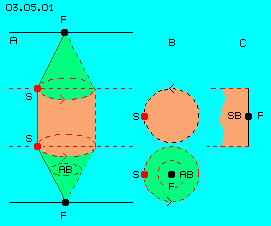 That situation here is drawn at picture 03.05.01 schematically once more. At A upside and down the layers of Free Ether (F) are marked, i.e. upside and downside of this level, the aether is moving only by narrow movements, so here is assumed to be (relative) stationary.
Between these levels a layer (resp. cylinder) is drawn, within which the aether is swinging at a circled track. The difference between null movement and that swinging motion (S) is possible, because within each balancing area (AB) the circled tracks become smaller, cone-like towards the resting Free Ether (F).
That situation here is drawn at picture 03.05.01 schematically once more. At A upside and down the layers of Free Ether (F) are marked, i.e. upside and downside of this level, the aether is moving only by narrow movements, so here is assumed to be (relative) stationary.
Between these levels a layer (resp. cylinder) is drawn, within which the aether is swinging at a circled track. The difference between null movement and that swinging motion (S) is possible, because within each balancing area (AB) the circled tracks become smaller, cone-like towards the resting Free Ether (F).
At this picture at B a cross-section (red) is shown. A swinging aetherpoint (S) of that middle layer moves at this circle. Below is shown a view top down onto the balancing area (green). The aetherpoints there are swinging at circles of each smaller radius.
The whole middle cylinder (red) thus is swinging relative vehemently. Within the gapless aether, all neighbours must synchronously swing analogue, also into all sideward directions, so an unlimited area of swinging movements (SB) would result. If however that motion should be locally limited, thus at its borders again should exist resting Free Ether (F). So round about any limiting border is demanded (like marked schematically at C).
Objective of this chapter now is, which kind of movement pattern the local aether movement must show, so that ´vortex´ becomes embedded within the resting aether.
Tilt and Shift
At picture 03.05.02 is shown only the conus of downside balancing area. At A the observed aetherpoint (red) is located quite left at its circled track. A neighbouring aetherpoint (blue) of this swinging layer (S) is drawn left. Further neighbours schematically are marked by black horizontal connecting lines, also further down at the balancing area (AB) to the layer of Free Aether (F).
At B is shown the situation after swinging at a half circle. The observed red aetherpoint now is located quite right side, its blue neighbour still is some left. The green section of the balancing area now shows, all horizontal neighbours keep same position relative to each other. However, the connecting lines are shifted relative to each other, i.e. vertical neighbours take other positions relative to each other.
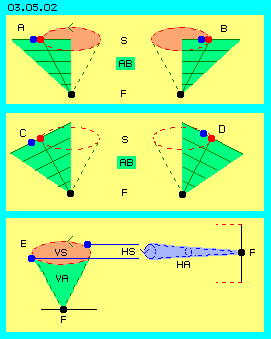 This ´rubbing´ between bordering layers (here between vertical neighbouring aetherpoints) however is not possible within a gapless aether. So local aether movement can not work that kind. An alternative is shown at this picture at C.
This ´rubbing´ between bordering layers (here between vertical neighbouring aetherpoints) however is not possible within a gapless aether. So local aether movement can not work that kind. An alternative is shown at this picture at C.
All neighbours at connecting lines between Free Aether (F) and observed swinging aetherpoint (S) move at tracks, which at a whole represent a cone (marked by dotted lines). Now here the neighbours are marked right angled to the connecting line. The length of each line marks each diameter of swinging with top down each smaller size.
If all neighbours of that cone should keep positions unchanged relative to each other, these aetherpoints would tilt while moving at circled track, like here at D is marked after a half turn. This pattern of movement thus is to compare with a tumbling spinning top - however aether don´t rotate-around but only swings-around. The blue aetherpoint is left and keeps left side of observed red ether point all times.
Local aether movements behave not exactly like this simple pattern of movements, however this consideration gives a decisive hint. As the blue neighbour moves at circled track and is tilting same time, that aetherpoint takes different levels: left side this point is positioned below and right side it is positioned above its red neighbour.
Lift and Lower
At this picture at E the difference of levels (relative to level of Free Ether) is pointed out. The blue aetherpoint is lifted and lowered while it´s tumbling and tilting. Again, within the gapless aether this movement can not be linear, but can (and must) be done by continuous turning resp. swinging. Lift and sink thus is done during the swinging around a horizontal axis.
Besides the first swinging around the vertical axis (VS) with its vertical balancing area (VA) so now a second swinging around the horizontal axis (HS) occurs. This additional swinging now can become smaller within a horizontal balancing area (HA), again cone-like into sideward direction - reaching out to the Free Aether (F).
Finally by these simultaneous two swinging motions around two axis right angles to each other, a coarse motion at a centre becomes locally limited towards outer border resp. neighbouring Free Aether. Thus again: at least two motions are given within the aether, at the universal aether movements like now here at local aether movement.
Uneven Track
At picture 03.05.03 this simultaneous swinging is shown. Coordinates are drawn for better orientation. The original swinging movement at horizontal plane is marked red. The swinging movement right angles to that first motion is marked blue. The Free Aether (F) is marked by black points. The observed moving aetherpoint is marked red. Diverse positions while the swinging movements are marked by east, south, west, north.
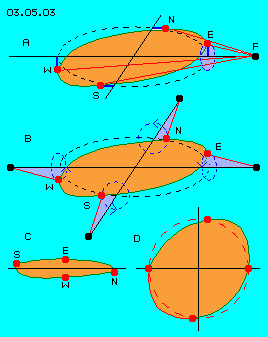 At A for example is shown, the aetherpoint at east (E) is positioned upside, at south (S) left side, at west (W) below and at north right side, each relative to the coordinates. So the layer of the original circled track (red) now is inclined to the equatorial plane.
At A for example is shown, the aetherpoint at east (E) is positioned upside, at south (S) left side, at west (W) below and at north right side, each relative to the coordinates. So the layer of the original circled track (red) now is inclined to the equatorial plane.
At B is shown each connecting line between Free Aether and the swinging aetherpoint at its four positions. By blue triangles is marked, which position that point takes in relation to these coordinates at each situation.
Each swinging around an axis is marked by dotted circles, each direction is marked by arrows. By view from outside, all connecting lines swing counter clock-wise. If generally the left-turning is assumed to be prevailing within the universe, so the aether at borders of that local ´aether-vortex´ would turn synchronously. Further down is discussed, how that ´impossible´ embedding of simultaneous movements into the gapless aether really works.
Here however at first is to mention a further special fact: different lengths of track sections. If the aetherpoint starts at its position at east (E) and moves to position south (S), that point has to go a rather long distance from upside of east-axis towards left side of south-axis.
From there to position below the west-axis, the distance is shorter. From west to north the distance again is longer, from north to east the distance again is some shorter. So the swinging around can not occur by constant speed or the track of that aetherpoint can not be a pure circle.
At C is shown a cross-sectional view through that ´movements-disc´. At east (E) the aetherpoint is upside of the axis, at west it´s below, at south and north thus the aetherpoint can not be exact at the level of the axis. So the new track would show a shape like the border of hat, bended upward one side and bended downward opposite side.
At D schematically is shown, the aetherpoint could walk the long distances some inside and make some ´excursions´ at section of short distances. The track thus would be no pure ellipse, but a deformed circle with depressions and extensions. The real tracks of local aether movements will be compromise in shape of diverse spiral track sections.
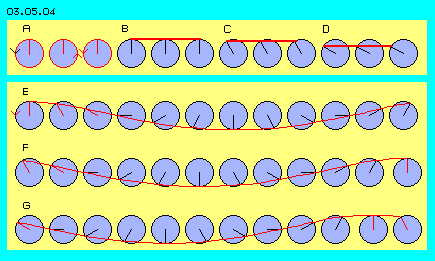 Wheel or Wave
Wheel or Wave
At previous pictures, this swinging around a horizontal axis was symbolized by little blue wheels. It was assumed, the wheels would turn left (by view from outside to the centre) and would turn at all four directions resp. towards all sides by likely sense. Involved problems schematically are shown at picture 03.05.04.
At A are drawn three left-turning wheels, where between the wheels a counter-turning movements exists (see arrows). So there would come up rubbing within the aether. This kind of neighbouring turnings can not exist in gapless aether.
Within the aether continuum can only exist relative synchronous swinging movement. By example of some wheels this possibility is demonstrated at B, C and D. Three wheels are connected with a rod (e.g. like drive-wheels of steam engine). All three wheels turn same sense, here e.g. from 12- via 11- to 10-o´clock-position, so all points at connecting line swing parallel to each other.
At this picture at E are drawn twelve wheels, instead of previous stable rod now combined by a bended connecting line (of neighbouring ether points). This connecting curve is ´mounted´ at each wheel at next position (here each hour of clock).
All wheels now can turn synchronously - and the connecting line will appear like a wave running from right to left, visualized by that little animation. Above this, here once more is demonstrated the essential difference between turning-around and swinging movement: turning around an axis is common within the material world, swinging at circled track (resp. at overlaid circles of different axis and radius) is the exclusive movement possibility within aether by itself.
 This animation also shows clearly, towards outside come up impressions or occurrences or effects, while their real movement pattern is quite other kind: here one can see absolutely clear a wave running from right to left - however one must watch exactly to recognize, twelve ´clock-hands´ synchronously are turning, each at its only small area. So the impression of far-reaching movement really results of aetherpoint motions at only small radius, all in likely turning sense - however ´phase-shifted´.
This animation also shows clearly, towards outside come up impressions or occurrences or effects, while their real movement pattern is quite other kind: here one can see absolutely clear a wave running from right to left - however one must watch exactly to recognize, twelve ´clock-hands´ synchronously are turning, each at its only small area. So the impression of far-reaching movement really results of aetherpoint motions at only small radius, all in likely turning sense - however ´phase-shifted´.
Overlaid Turnings
Upside at section ´Uneven Tracks´ of picture 03.05.03 was mentioned, the sections of track have different lengths. From east to south and from west to north the distances are longer than from south to west and from north to east. At previous twelve ´wheels´ resp. at the wave of previous animation with its bended connecting curve, this problem is not quite obvious, nevertheless these differences exist.
At picture 03.05.06 again are drawn these ´wheels´ (blue) and a stable connection (red). The connecting line A between 12- and 11- o´clock-positions is much longer than e.g. the connecting line B between 9- and 8-o´clock-positions. Within the gapless aether however, such movement processes are not possible.
At earlier chapter overlays the processes of sea waves were discussed and e.g. at picture 03.02.03 (at B, C and D) were shown tracks resulting of two overlaid circled movements.
Here at picture 03.05.06 at C and D e.g. around previous ´fixing-points at one wheel´ occurs a second turning (grey) at relative short radius. This second turning point thus wanders at circled track within space and around its wandering fulcrum exists a second synchronous turning (and all turnings occur by constant speed). Connecting lines with sections of continuously same length are achieved by overlays like this, for example shown at C and D.
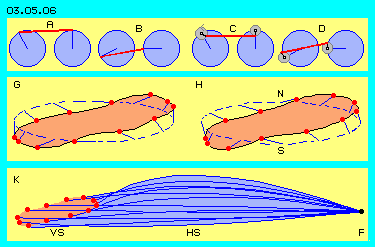 Roundabout at Roller Coaster
Roundabout at Roller Coaster
Previous twelve wheels of picture 03.05.04 resp. ´clock-hands´ of previous animation, in reality are arranged around the centre of a swinging plane. Previous wave runs around this motion centre, as an appearance of swinging motion around the horizontal axis (HS) and as necessary supplement of the original swinging around vertical axis (VS).
Instead of previous two-dimensional drawings, now here at picture 03.05.06 at G previous ´clock-hands´ (blue) are arranged at circle (blue dotted). Resulting is a circulating wave (black) with its uneven track resp. ´inclined´ disc (red).
At H the result of previous overlay schematically is shown. The ´clocks´ stay back phasewise, so e.g. at south (S) the 9-o´clock-position is not quite achieved and at north the 3-o´clock-position is not jet achieved (by this turnings counter-clock-wise). At phases between, the clock is ´running faster´, so as a whole all sections are of likely length.
An other possibility for balancing the differences of connecting lines is also drawn here. The ´clock-hands´ not at all must stand right angled to the equatorial plane, but could be inclined towards inside / outside. The upper border of this band around the centre here e.g. is tilt some towards left. Even during the circulation, the tilting angles could change (and will in reality change continuously and will in reality show much larger angles than drawn here).
Swinging Connecting Line
At this picture at K, once more an inclined uneven track is drawn. At the centre of this local movement (red) can exist no pure circled track and also no pure elliptic track. There are at least one swinging around the vertical axis (VS) and (phase-shifted) a second swinging motions around (many) horizontal axis (HS) overlaying.
The connecting lines (blue) between the observed aetherpoint at the centre and one point (black) of Free Aether (F) can be no straight stable line (like assumed simply at previous cone-like motions). Most similar movements do the aetherpoints neighbouring at a spiral bended connecting lines.
At this picture at K a bundle of diverse shapes of connecting line are drawn. While one turn of the central aetherpoint at an inclined track, the connecting line must change these shapes. All points at this connecting line do similar movements, thus not only are swinging around their horizontal axis, but are moving same time to left resp. right. So not only within the centre exists motion, but roundabout are heavy motions, all times into all three dimensions. Towards the surrounding Free Aether however, the distances of movements become shorter, i.e. the swinging is faded towards outward ´border´.
 This simple animation visualises the steady changed winding of the connecting line. The observed aetherpoint (red) in phases moves upside or downside of the equatorial plane. Its distance to the Free Aether becomes shorter and longer, equalized by the bending and winding of the connecting line (like shown in details next chapter). However, the movement at the centre is overdrawn extremely. In the reality, the balancing area towards the Free Aether is extreme large in relation to the small motions within the centre, by millions and billions.
This simple animation visualises the steady changed winding of the connecting line. The observed aetherpoint (red) in phases moves upside or downside of the equatorial plane. Its distance to the Free Aether becomes shorter and longer, equalized by the bending and winding of the connecting line (like shown in details next chapter). However, the movement at the centre is overdrawn extremely. In the reality, the balancing area towards the Free Aether is extreme large in relation to the small motions within the centre, by millions and billions.
Symmetry and Asymmetry
One can see, there is no complete symmetry. Symmetric is only the connecting line from one point of Free Aether to the opposite at the drawn (X-) axis.
A connecting line cross to X-axis (thus alongside Z-axis) shows other shape and changes by other curves. By this view, e.g. most short and most long distances to the observed aetherpoint are not at its position most upside resp. downside of axial plane, but at its position aside of the Z-axis.
Within the plane of this axis-cross thus exists a horizontal balancing area from the centre of movements outwards to the Free Aether. Within this area however, balancing movements are not of unique shape. Only exactly opposite, movements are mirrored analogue. Diagonal to previous X- and Z-axis exists smooth transition of both movement´s pattern.
The track at the centre is inclined to the equatorial plane of this axis-cross, resulting the asymmetric bundle of connecting lines of previous picture at K. Naturally there are also connecting lines by view direct onto that plane, thus from a point of Free Aether some above of the previous animation. This connecting line again will show other shape and some other behaviour.
These fictive connecting lines are theoretically given from all Free Aether around this local motion centre, thus from any direction e.g. of half-sphere above this axis-cross. At earlier pictures (e.g. at both first pictures of this chapter) were drawn only simple straight connecting lines of cone-like vertical balancing area. Similar movements however also there are not at straight lines, but the neighbouring points at spiral curves do likely movements.
At following chapter ´Tumbling Axis´ the movement pattern along this Y-axis are discussed and how the connecting lines must be bended in general.
| 03.06. Tumbling Axis | Aether-Physics and -Philosophy |